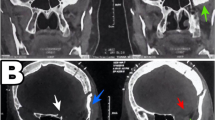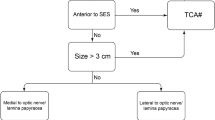Summary
By reviewing the operative history of 20 meningioma cases displaying midline subfrontal and presellar localization, the author found that in 5 cases the growth was attached to the lamina cribrosa and the crista galli, in 3 cases it was attached adjacent to the tuberculum sellae, but spreading onto the limbus sphenoidale also; in 12 cases it was found adhering to the sphenoid plane. The high proportion of meningiomata attached to the planum seems noteworthy, for this variety does not appear to have been properly recognised before. After a consideration of the clinical and radiological data of these 20 patients, the author is of the opinion that the planum meningiomata deserve to be classified as a separate group. Their segregation becomes possible by correct evaluation of the history, the clinical picture, and the radiological data. The attachment of the planum meningioma is on the os sphenoidale, while the olfactory meningioma is attached to the os ethmoidale. The OM usually destroys the floor of the anterior scala, whilst the PM creates bony elevations (hyperostoses and exostoses) upon it. It is true that the tuberculum and the planum meningioma are attached to the same bone and that the boundary provided by the limbus may become indistinct, but while the attachment of the former is generally indicated by a simple hyperostosis or destruction, the attachment of the latter is generally characterized by hyperostoses as well as by bone elevations.
Based of the above-mentioned findings the author deems it reasonable to classify the PM as an independent variety separate from the TM and the OM.
Zusammenfassung
Bei der Analyse der Operationsbefunde von 20 Meningiomen der Mittellinie subfrontal und präsellär fand der Verfasser 5 Fälle, die von der Lamina cribrosa und der Crista galli ausgingen, 3 Fälle mit einem Ausgangspunkt am Tuberculum sellae und dem Keilbeinflügelrand, und 12 Fälle, die vom Planum sphenoidale aus wuchsen. Die relativ hohe Häufigkeit von Meningiomen des Planum sphenoidale schien bemerkenswert, denn es scheint als wäre diese Variante bisher nicht beobachtet worden.
Nach einer Durchsicht der klinischen und radiologischen Daten dieser 20 Patienten vertritt der Verfasser die Ansicht, daß die Meningiome des Planum sphenoidale als eigene Gruppe herausgestellt werden sollten. Die Unterscheidung wird möglich durch genaue Analyse der Vorgeschichte, des klinischen Befundes und der radiologischen Untersuchungsergebnisse.
Die Meningiome des Planum sphenoidale gehen vom Keilbein aus, während die Olfactoriusmeningiome am Os ethmoidale haften. Das Olfactoriusmeningiom zerstört in der Regel den Boden der vorderen Schädelgrube, während die Meningiome des Planum sphenoidale Knochenverdickungen (Hyperostosen und Exostosen) hervorrufen.
Zwar gehen die Meningiome des Tuberculum sellae und des Planum sphenoidale vom gleichen Knochen aus, so daß die durch den Keilbeinflügelrand markierte Grenze nicht ganz scharf sein kann, doch ist der Ansatzpunkt der ersteren gekennzeichnet durch eine einfache Hyperostose oder Zerstörung, während die Ausgangsstellen der letzteren im allgemeinen sowohl Hyperostosen als auch Knochenerhebungen haben.
Gestützt auf die oben geschilderten Befunde hält es der Verfasser für sinnvoll, das Meningiom des Planum sphenoidale als eigene Gruppe vom Tuberculum-Sellae-Meningiom und vom Olfactoriusmeningiom abzugrenzen.
Résumé
En passant en revue les comptes rendus opératoires de 20 cas de méningiomes médians sous-frontaux et présellaires, l'auteur trouve que dans 5 cas la tumeur était attachée à la lame criblée et à la crista galli, que dans 3 cas elle était attachée sur le tubercule de la selle mais s'étendait aussi vers le limbus sphénoïdal et dans 12 cas elle fut trouvée adhérant au jugum sphénoïdal.
La grande proportion de méningiomes attachés au jugum semble digne d'attention, car cette variété ne paraît pas avoir été convenablement admise auparavant.
Après une considération des données cliniques et radiologiques de ces 20 malades, l'auteur exprime l'opinion que les méningiomes du jugum devraient être classés dans un groupe séparé.
Leur séparation devient possible par une correcte évaluation de l'histoire de la clinique et des données radiologiques.
L'attache du méningiome du jugum se fait sur l'os sphénoödal tandis que celle du méningiome olfactif est sur l'os ethmoïdal.
Le méningiome olfactif détruit habituellement le plancher de l'étage antérieur, tandis que le méningiome du jugum crée des proliférations osseuses (hyperostoses et exostoses).
Il est vrai que les méningiomes du tubercule et du jugum sont attachés au même os et que la limite créée par le limbus peut devenir indistincte, mais tandis que l'attache du premier est généralement signalée par une légére hyperostose ou destruction, l'attache du second est généralement caractérisée par des hyperostoses aussi bien que par des constructions osseuses.
En se basant sur les résultats mentionnés plus haut, l'auteur pense raisonnable de classer les méningiomes du jugum comme une variété indépendante séparée des méningiomes du tubercule (T. M.) et des méningiomes olfactifs (O. M.).
Riassunto
Rivedendo la descrizione dell'intervento di 20 casi di meningiomi a localizzazione mediana subfrontale e presellare, l'autore constata che in cinque casi il tumore era attaccato alla lamina cribrosa ed alla crista galli, in tre casi alle adiacenze del tuberculum sellae, ma con espansione verso il limbus sfenoidale, ed in 12 casi era aderente al piano sfenoidale. L'alta percentuale di meningiomi aderenti al piano sfenoidale sembra notevole, soppratutto in quanto non è stata mai riconosciuta prima d'ora. Considerando gli aspetti clinici e radiologici di questi 20 pazienti, l'autore è dell'opinione che i meningiomi del piano sfenoidale debbano essere classiflcati come un gruppo indipendente. La loro classificazione separata è resa possibile da una corretta valutazione della storia clinica, del quadro clinico e dei dati radiologici. Il meningioma del piano sfenoidale è attaccato all'osso sfenoidale, mentre il meningioma olfattorio è attaccato all'etmoide. Il meningioma olfattorio generalmente distrugge il pavimento della scala anteriore, mentre il meningioma del piano crea delle iperostosi o delle esostosi. È vero che il meningioma del tubercolo e quello del piano sfenoidale sono aderenti allo stesso osso, e che il limite segnato dal limbus può diventare indistinto, ma mentre la sede d'impianto del primo è generalmente indicata da una semplice iperostosi di distruzione, la sede d'impianto del secondo è generalmente caratterizzata da una iperostosi che si accompagna ad elevazione ossea.
Basandosi su queste considerazioni l'autore ritiene che sia ragionevole classificare i meningiomi del piano sfenoidale, come una varietà indipendente di quelli del tubercolo e di quelli olfattori.
Resumen
Revisando las reseñas operatorias de 20 casos de meningiomas situados entre localizaciones mediales, subfrontales y paraselares, el autor encuentra que en 5 casos el tumor estaba implantado en la lámina cribrosa y en la crista galli, en 3 casos se implantaba cerca del tuberculum sellae pero extendiendose también hacia el lumbus esfenoidal y en 12 se encontró que estaban adheridos al jugum esfenoidal.
Parece digna de atención la gran proporción de casos implantados en el jugum, pues anteriormente esta variedad no parecía estar muy admitida.
Después de considerar los datos clínicos y radiológicos de estos 20 enfermos el autor opina que los meningiomas del jugum deberian clasiflcarse en un grupo aparte.
Su separatión puede hacerse mediante una correcta valoración de la historia, cuadro clínico y datos radiológicos. La implantación de los meningiomas del jugum se hace en el hueso esfenoidal, mientras que los del olfatorio se implantan en el hueso etmoidal.
El meningioma olfatorio destruye el suelo de la escama anterior, mientras que el meningioma del jugum ocasiona elevaciones del hueso (hiperostosis y exostosis) por encima de él.
También es cierto que el meningioma del tuberculum y el del jugum se implantan en el mismo hueso y que los límites impuestos por el limbus pueden ser poco significativos, pero mientras la forma de implantatión del primero se señala generalmente por una simple hiperostosis o destructión, la implantation del ultimo se caracteriza generalmente por hiperostosis y también por elevaciones oseas.
Basandose en los hallazgos anteriormente mencionados, el autor crée razonable clasificar los meningiomas del jugum como una variedad independiente y separada de los meningiomas del tuberculum y del olfatorio.
Similar content being viewed by others
Author information
Authors and Affiliations
Rights and permissions
About this article
Cite this article
Hullay, J. Planum (jugum) sphenoidale meningioma. Acta neurochir 12, 717–745 (1965). https://doi.org/10.1007/BF01404622
Issue Date:
DOI: https://doi.org/10.1007/BF01404622




